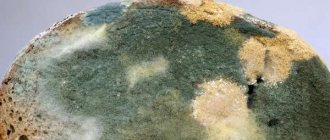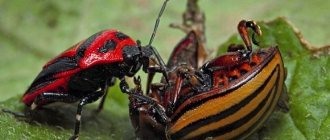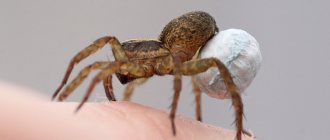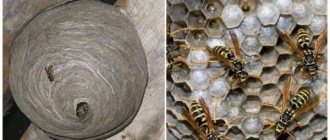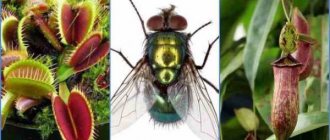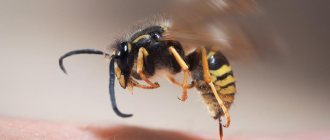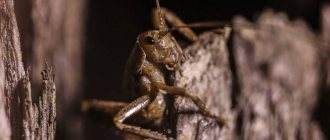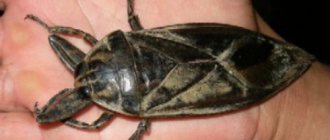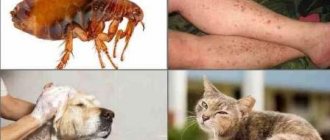"Kissing bug" is the common name for a bug called triatomine. The beetles get their name because they leave bite marks on the face. The main risk associated with insect bites is the presence of a parasite in their feces, which can cause Chagas disease in humans. Although infections with this parasite are not common, complications can be serious and require early treatment.
Kissing bugs, or triatomines
, feed on the blood of people and animals. They are nocturnal, meaning they hide during the day and are active at night. Beetles often bite and feed on the blood of a person while he sleeps. Their saliva contains a compound that causes numbness at the site of the bite, so the person often does not feel the bite. The beetles are attracted to the carbon dioxide that people exhale. This is why they bite people on the face, near the mouth and around the eyes.
Kissing bugs typically live in areas with plenty of food sources, such as forests, where rodents and birds live. Bugs can enter your home from almost any opening. They are a serious problem in South and Central America, as well as Mexico. About 8 million people in these areas have Chagas disease.
Kissing beetles are difficult to identify, some key characteristics of the beetles include:
- long oval body with six legs
- thin, cone-shaped head with long antennae
- color from light brown to black
- yellowish-red or brown markings on the body
Bite symptoms
Kissing bug bites are similar to other insect bites. Sometimes a person may not even notice that he has been bitten. Others may notice clusters of small bite marks around the mouth and eyes. However, some people may have an allergic reaction to the stings. They begin to experience itching, swelling and redness around the bites. These symptoms are painful but usually go away with antihistamines.
In cases of a severe allergic reaction, a person may develop welts around the bites or hives. In very rare cases, a person may go into anaphylactic shock.
Giant Asian shemale
The location of its location is clear from the very name of the insect. Compared to other brothers, it reaches a truly gigantic size - approximately 5 cm in length with a wingspan of 7.
Its sting is no shorter than 5 mm, and in addition to the fact that the bumblebee attack itself is extremely painful, there is a whole mixture of various poisons that will be fatal to a person with poor health or an allergy sufferer. In general, if you see something like this, it’s better to stay away.
Chagas disease
The main risk of being bitten by a kissing bug is infection with Chagas disease. Chagas disease
is the common name for infection by the parasite
Trypanosoma cruzi
. Not all triatomines have the Trypanosoma cruzi parasite, but it is very common. It is important to note that the overall risk of infection from the parasite is low. The only way for infection to occur is if the parasite gets into an open wound or mucous membrane. This can happen if a person accidentally rubs their eyes or mouth with a contaminated hand. Triatomines that have the Trypanosoma cruzi parasite do not always transmit it, and simply being bitten does not mean a person will develop Chagas disease.
Symptoms of Chagas disease
Chagas disease has two stages. In the acute phase, which occurs in the first few weeks after infection, the person does not experience any symptoms. If they exist, they look like the flu. Symptoms include:
- body pain
- chills
- fever
- rash
- enlarged lymph nodes
- loss of appetite
- diarrhea
- vomiting
These symptoms are a reaction to a parasite circulating in the body. Some children may also experience eyelid swelling due to an eye infection. Once this phase ends, the disease will enter the chronic phase. During the chronic phase, symptoms will disappear on their own as the number of parasites decreases without treatment. However, the infection is still present in the body and this poses a greater risk in the chronic stage. Even in chronic cases, people have no other symptoms. However, doctors note that 20-30% of people may experience serious heart and gastrointestinal problems years later, including:
- enlarged heart
- heart rhythm disturbances
- thinning of the colon
- thinning of the esophagus
These complications can be serious or fatal, so it is important to see a doctor if a person suspects Chagas disease. Successful treatment in the acute phase is the only way to prevent the chronic phase.
The most dangerous insects in the world
The most dangerous insects in the world are creatures that live in different parts of the planet. They endanger humans and animals in various ways: they sting and release poison, carry various diseases, or create a lot of trouble just by their presence. There are more than 30 million species of insects, but among them there are a dozen of the most dangerous, whose small size creates a misleading impression of their harmlessness.
10 Bullet Ant
If a bullet ant or diurnal ant makes a cry, it means it is ready to attack its prey. One of the most dangerous insects lives on a tree, where it grows its anthill, the height of which can be more than 10 meters. This species is common in South America and is distinguished by a powerful sting and paralyzing venom. The bullet ant is a predator. It feeds on both living and dead insects, but also loves sweet plant juice. He is considered a peaceful inhabitant of the tropics until danger threatens. If you have to defend yourself, the ant will first make a warning hissing sound, emit an unpleasant odor, and only then attack. Its bite is so painful that it is comparable to a bullet wound. Hence the name "bullet". And the pain experienced by the bitten person lasts a day, which gave the second name “daily” or “24 hours”.
9 Asian shemale
In Asia you can meet a very dangerous insect - the Asian bumblebee . It is difficult not to notice because its dimensions are impressive - 5 cm in length and wingspan - 7.5 cm. With its 0.6 cm sting, the bumblebee can sting many times in a row. In terms of pain, its bite is comparable to that of having a hot iron applied to the body. In addition, the poison has a specific smell, by which other bumblebees find the same victim and attack.
[CHOSEN FOR YOU] 10 interesting facts about radiation and its effect on humans
8 The Kissing Bug
The name “ kissing bug ” has nothing to do with the behavior of this dangerous insect, namely the bad habit of stinging a person on the lips. The beetle is attracted by the heat of the breath and the carbon dioxide released. He attacks at night. In tropical countries, the insect spreads a disease called Chagas disease, the symptoms of which can develop over several decades and cause heart failure in humans.
7 Flea
The flea or “a few millimeters of danger” is an insect from which humans have been suffering for many centuries. It was fleas that caused the plague that struck all of Europe in the 12th century and killed 15 million people. First of all, the danger of fleas is that they are carriers of many dangerous diseases such as encephalitis, typhus, anthrax and various helminthiases. During evolution, they lost the ability to fly, but their mouth became capable of biting through the thick skin of the victim and drinking its blood.
6 Tsetse fly
The tsetse fly is an equally dangerous insect that lives in Africa, as it is a carrier of sleeping sickness. It is distinguished from an ordinary fly by its long proboscis and a pattern on its wing that resembles a butcher's knife. An interesting fact is that tsetse does not attack only zebras, since for flies it is a continuous ripple of stripes. It attacks other animals and humans with lightning speed. Tsetse attack any object that emits heat. They can even attack a running car. There has been and is a constant struggle with tsetse. Good results were shown by an experiment during which a large number of flies were caught. The captured males were sterilized and released into the wild. The females fertilized by them did not give birth to offspring. Thus, it was possible to significantly reduce the population of dangerous killers.
[CHOSEN FOR YOU] 12 striking facts from the biography of Playboy founder Hugh Hefner
5 Africanized bee
The Africanized bee turned into one of the most dangerous insects by accident. The scientist who brought the Kerra breed from Africa accidentally released the bees and the females crossed with drones. The result of the mix was a very aggressive bee. This species is very hardy and strong. Bees are capable of attacking houses in swarms and killing animals and people, which is why they are nicknamed “killer bees.” No one risks approaching their hive, otherwise there is a risk of death. Bees are capable of chasing prey for several kilometers. Even if a person dives into the water to hide from his pursuers, they will circle above the surface for a long time and wait for the victim. Insects do not calm down like European bees in an hour, but remain in an aggressive state for up to 8 hours.
4 Pliers
Ticks are a real danger to humans and animals. They are able to smell prey from a distance of ten meters, hide in the grass and wait patiently. With the help of legs with suction cups, ticks move nimbly over their prey. They mainly tend to the armpits, groin, and neck. Moreover, ticks can survive without food for several years, but when given the opportunity to eat, they become insatiable. Ticks eat so much that their weight can increase a hundred times its original weight. In total there are about 50 thousand species. For humans, the most dangerous are ticks that transmit encephalitis, which affects the human nervous system and brain, often leading to disability and even death.
3 Lonomiya
Lonomia or “lazy clown” is an insect that exudes danger. Residents of South America are afraid of a chance meeting with this beauty. Beneath the bright and beautiful caterpillar lies a dangerous killer. The villi that cover the entire body of the lonomia secrete a powerful poison. A person who touches a caterpillar almost instantly has kidney failure, internal bleeding begins and the body becomes covered with bruises. If there was contact with several individuals at once, then this threatens cerebral hemorrhage. It is very difficult for a person to recover from such exposure to poison. All victims of the lazy clown remain disabled.
[CHOSEN FOR YOU] 25 unusual things that you will only find in Japan
2 Gadfly
The gadfly is a well-known insect that mainly attacks cattle, but in South America there is a common subspecies that is dangerous to humans. More precisely, the larvae of this insect are dangerous. Females lay larvae in the epidermis, where they develop for 2 months. In this case, a noticeable cone-shaped tubercle is formed and the person feels movement under the skin. When the larva matures, it comes out and this process is very painful. The gadfly, due to its reproductive principle and the appearance of the larvae, is also considered one of the most terrible insects.
1 Mosquitoes
Every minute in the world a person suffers from a mosquito bite . They are responsible for the most human deaths, which is why mosquitoes are the most dangerous insects in the world. The mosquito has a long proboscis that easily penetrates human skin. Its flight is silent and the landing on the body is not felt at all. Only females drink blood because they need it for procreation. After the bite, malaria develops within half an hour, which affects the blood and liver. Entire herds of animals can die from mosquito bites, or rather from blood poisoning. And in Suriname there is still a type of death penalty, when mosquitoes are released on the convicted person.
How to get rid of kissing bugs
Insect sprays are a common insect repellent. Synthetic pyrethoid sprays have been successful in getting rid of insects, although they are not specifically approved for use.
Chemically treated curtains and bedding can help kill kissing insects. To prevent infestation, it is important to take measures to reduce possible entry of these insects:
- use of screens in all windows, doors and vents
- repair or replace any worn screens in windows and doors
- sealing any cracks or gaps between windows, walls and floors
- removal of bushes, branches and stone piles near the house
- turning off lights around the house at night as they may attract insects.
Avoid squashing insects as this may expose you to parasites. Instead, place them in a container and fill it with alcohol or freeze it.
Clean surfaces the beetle comes into contact with using alcohol or a bleach solution.
Black Widow
Surely, many have already heard more than once that this type of spider is especially dangerous to health and life. They are found in warm and hot climates, without particularly “interfering” in the affairs of the people around her. But that is until someone disturbs the widow’s nest.
Then the spider becomes a furious aggressor, who will not be intimidated by the enemy’s many times greater size. Depending on the size of the individual, the possible damage varies. This can be both serious poisoning and death. The latter, however, does not happen so often, but history has recorded enough similar cases to treat this insect with due respect.
When to see a doctor
Although serious infection does not occur in every case, precautions should always be taken. A person living in the southern regions of the United States, Mexico, or Central America who notices insect bites on the face should consult a doctor.
If you have flu-like symptoms that appear within a few weeks of the bite, you should see a doctor for diagnosis and possible treatment.
Related scientific article: Hospital insects harbor antibiotic-resistant bacteria.
Stray Ants
They are often found in Africa or South America, but similar colonies can also be found in certain parts of Asia. They are not dangerous individually, they are dangerous as a group. Unlike ordinary ants, these “vagrants” do not establish a permanent place of residence, but wander from place to place.
At the same time, nomadic individuals can number up to several tens of millions of individuals! And such a column of marching ants, which can stretch for several kilometers, is a mortal threat to any living creature in its path. After all, such a mass can in a short time kill and gnaw a person or a large four-legged animal, not to mention our smaller brothers, the lemur or baboon.
Chagas disease and its symptoms
Statistics show that infection with Chagas disease due to a kissing bug bite occurs in only 10% of people bitten.
However, there are other, simply shocking statistics: when autopsies were performed on the bodies of Latinos who died from a heart attack or acute heart failure, it was discovered that half of them had chronic Chagas disease.
The medical significance of this fact is beyond doubt. The danger is that even a month or more after a parasite bite, symptoms of the disease may not appear, although it is believed that this should happen within 1-2 months after infection.
Chagas disease is manifested by the following symptoms:
- heart pain and shortness of breath;
- the appearance of swelling of the eyelids;
- general weakness and fatigue;
- poor health, often accompanied by dizziness;
- elevated temperature;
- stool disorders, nausea and vomiting;
- a rash may appear.
All these symptoms indicate trypanosome damage to the heart muscle, blood vessels and lymph nodes, after which death occurs within a couple of months or at most several years.
At the same time, the patient does not even suspect that he has become infected with Chagas disease, and treats the heart, but trypanosomes continue to multiply and affect, in addition to the heart, also the skeletal system, gastrointestinal tract and kidneys.
Triatomine bugs are the main sources of trypanosome infection, but this pathogen can also be transmitted in other ways, for example:
- when receiving contaminated blood transfusion or organ transplantation from a donor who is a carrier of the infection;
- from an infected mother to the fetus;
- through food or household items containing kissing bug feces.
Get tested for Chagas disease
Diagnosis of Chagas disease
Considering the asymptomatic course of the disease, its timely diagnosis becomes especially important, because saving a person’s life depends on it.
The following methods are used to diagnose this disease:
- blood smear analysis (performed several times);
- blood culture on various media;
- injecting healthy mice with the blood of the subject and then monitoring them and taking tests;
- xenodiagnosis.
The best option would be to use several diagnostic methods at once to more accurately identify the parasite.
Morphology and life cycle
The body size of these parasites is usually no more than 2 cm, but they have long limbs and wings that allow them to fly.
The color is dark and inconspicuous. The head is cone-shaped with a thickened proboscis, which is sensitive to infrared radiation.
Thanks to him, they find the warmest places on a person’s face (lips, skin around the eyes) and stick to them, but the main thing is that the bedbugs defecate next to the bite site.
The hunt takes place at night, and a sleepy person, without waking up, scratches the bite site and at the same time rubs kissing bug feces into it, containing trypanosomes - parasitic single-celled organisms that cause Chagas disease.
They are carried throughout the body through the bloodstream and can cause irreversible consequences.
Thus, these flying insects are dangerous not in themselves, but because their excrement contains the causative agent of a dangerous disease, and they act as its hosts.
Their life cycle is quite simple and consists of 5 stages, after each of which the insect moults. After the final stage, it takes on the appearance as in the photo, that is, it turns into an adult with wings.
These insects often live close to human habitation (and potential food sources), as well as in the burrows of small rodents, where they have shelter from insectivores and ready food - the blood of their owners.
Article on the topic: “Filaria”
